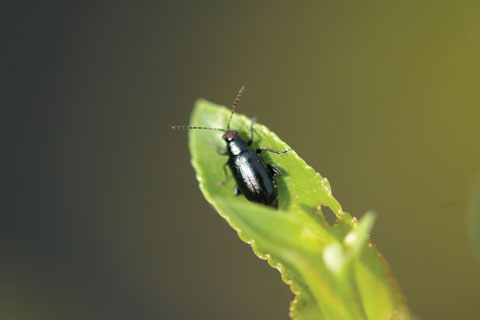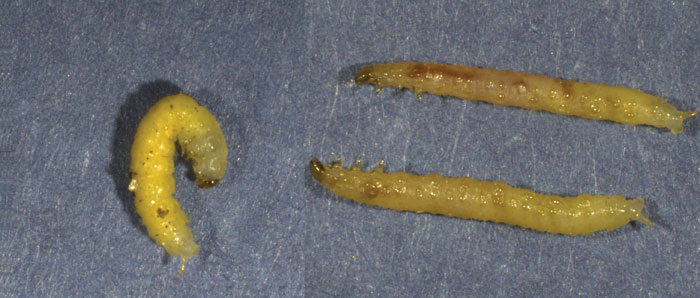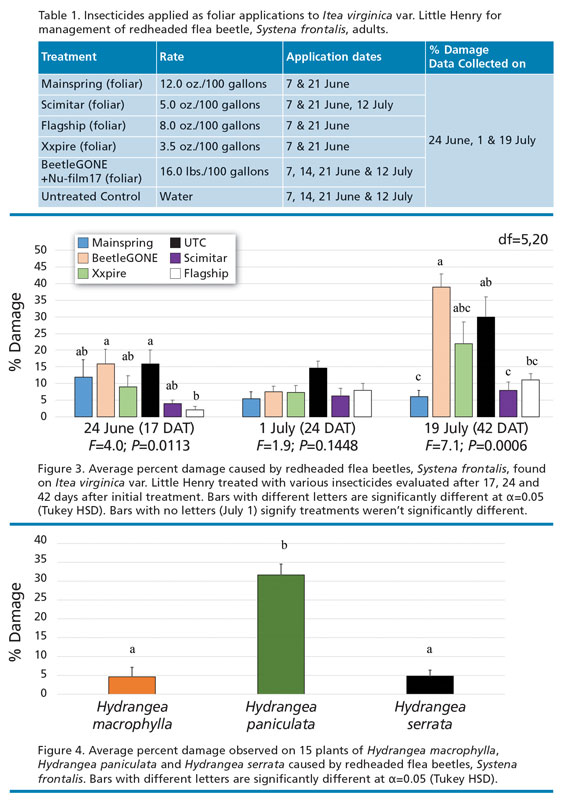8/1/2021
Redheaded Flea Beetles: An Invasive Native
Brian Kunkel

Flea beetles—including Altica spp. flea beetles and the redheaded flea beetle, Systena frontalis—are significant challenges to production of high-quality nursery stock across the Eastern U.S. The Southern Regional IPM Center recently developed a pest management strategic plan and flea beetles were rated as their second most important insect pest. This group of insects is moderate to somewhat difficult to control when encountered in nurseries. Flea beetle feeding delays the seasonal sale of plants until a new flush of growth occurs.
Figure 1. The redheaded flea beetle, Systena frontalis, sitting on a leaf early in the morning. Notice the brick reddish-colored head capsule. Photo: Brian Kunkel.
Redheaded flea beetles (Figure 1), also known as the cranberry flea beetle, are probably shipped from one nursery to another accidentally in the root balls of various plants, and have become a prevalent pest in the mid-Atlantic and southeast regions during the past decade. The larval stage (Figure 2) is found in root balls, but doesn’t cause noticeable injury to plants.
Joseph et al. (2021) surveyed nurseries and found that most need to manage S. frontalis on a yearly basis. This beetle feeds on plants from over 10 different families of plants, and some of the more commonly injured plants were hydrangea, itea, weigela, salvia, ilex, roses and azaleas.
Most of the survey respondents make insecticide applications that target adult beetles with neonicotinoids, carbaryl, pyrethroids or an organophosphate. Many respondents felt there’s a need for more effective insecticides. Few growers utilized entomopathogenic nematodes or entomopathogenic fungi.
 Redheaded flea beetles overwinter in the soil as eggs with larval feeding on plant roots in the spring. Larvae are creamy-white to yellowish, somewhat flattened and elongate, and pass through three instars. They have a small fleshy projection off the terminal segment of the abdomen and may appear to have a thin reddish-brown coloration within their body (Figure 2).
Redheaded flea beetles overwinter in the soil as eggs with larval feeding on plant roots in the spring. Larvae are creamy-white to yellowish, somewhat flattened and elongate, and pass through three instars. They have a small fleshy projection off the terminal segment of the abdomen and may appear to have a thin reddish-brown coloration within their body (Figure 2).
Figure 2. Late instar of redheaded flea beetles, Systena frontalis, found crawling on the outside of the root ball of itea after being removed from the container. Photo: Nancy Gregory.
The timing of insect activity may fluctuate depending on where a nursery is located. For example, larval stages have been found between 242 to 370 growing degree days with a 50F (10C) base (GDD50) in the mid-Atlantic with black locust in full bloom as a plant phenological indicator, whereas Lauderdale (2017) found larvae active 250 to 480 GDD50. Adult activity has been observed with Magnolia grandiflora flower buds swelling or beginning to open or 517 to 1028 GDD50 in the mid-Atlantic. This information is useful when scouting for insect activity, but many growers feel there’s still an inadequate amount known about the biology of this insect that could be used to better target management strategies.
Little is known regarding host plant preferences, adult beetle dispersal from weeds to crops, natural enemies or the number of generations per year. Research presented in the remainder of the article discusses results regarding insecticide efficacy and observed host plant preferences.

Redheaded flea beetle trials
Insecticide efficacy. The first trial examined the efficacy of a variety of insecticides (Table 1) against the adult stage of the redheaded flea beetle feeding on Itea virginica var. Little Henry. Plant damage was determined by estimating the percentage of leaves showing the skeletonization or holes caused by adult beetle feeding.
The damage estimates were recorded at 17, 24 and 42 days after the initial treatment (DAT). The second data collection point was 10 days after an insecticide application and the third data collection point was seven days after the final insecticide application in the trial.
Host plant selection. This set of observations examined the amount of damage found on three different species of hydrangea found at nurseries growing in the mid-Atlantic with similar levels of adult redheaded flea populations. Fifteen plants of Hydrangea macrophylla, Hydrangea paniculata and Hydrangea serrata were observed for two minutes for the number of adults found on the plant (not presented). The percent of skeletonization or defoliation caused by flea beetle feeding was estimated by three people for each plant and averaged before analysis.
Data analysis. Data was collected as described in each section and analyzed with an ANOVA and Tukey HSD means separation procedure (α=0.05) when significance was indicated. Data was transformed as needed for the analyses.
Results
Flagship significantly reduced adult redheaded flea beetle feeding damage on itea after 17 DAT (F=4.0; P=0.0113). Although BeetleGone was applied weekly prior to the first data collection, the amount of damage wasn’t significantly less than the control (Figure 3). Flea beetle populations were unusually low during the first portion of the experiment and may account for low percentages of damage found on plants in June.
None of the insecticides significantly reduced feeding damage to plants compared to controls during the second evaluation. Flea beetle populations greatly increased in the second half of the trial, and only Scimitar and Mainspring significantly kept feeding damage significantly less than untreated plants (F=7.1; P=0.0006; Figure 3). Untreated plants averaged 30% of the foliage damaged by beetle feeding at the conclusion of the trial.
Different species of hydrangeas are often grown close to each other at nurseries in the mid-Atlantic; consequently, each species is exposed to the same level of redheaded flea beetle feeding pressure. Observations found that H. paniculata suffered significantly greater foliage damage when compared to H. serrata or H. macrophylla (F=63.5; P<0.0001; Figure 4). Hydrangea paniculata suffered five to six times the amount of foliage damage on average compared to the other two species.
Summary
The redheaded flea beetle, Systena frontalis, continues to be a difficult insect to manage in nurseries throughout the eastern half of the United States. Scimitar and Mainspring significantly reduced adult beetle feeding by the end of the insecticide efficacy trial (Figure 3). Flagship reduced damage during the first evaluation, however, the residues from the application appear to be lessening at the conclusion of the trial.
Drench applications of Flagship or Mainspring may provide different results than those found in the trial presented here. Neither Xxpire nor BeetleGone reduced beetle feeding. Some research has found that imidacloprid applications also reduces adult feeding damage.
Redheaded flea beetles fed more on H. paniculata than other species of hydrangea in our study. There’s little information to suggest why redheaded flea beetles choose one species over others. The waxiness or toughness of leaves may contribute to host plant selection.
Some preliminary research and anecdotal observations suggest that plant fertility may play a significant role in host selection for the redheaded flea beetle. A better understanding of the roles played by soil moisture, host selection, plant fertility and dispersal capability of the redheaded flea beetle would help in developing a successful management strategy and needs further investigation. GT
Acknowledgements: Helene Doughty and Pete Shultz at Virginia Tech HRAREC have provided extensive support and efforts to this collaborative project. I also thank all the lab assistants for contributing to the completion of our different projects.
Brian Kunkel is an Ornamental IPM Extension Specialist at the University of Delaware in Newark, Delaware.